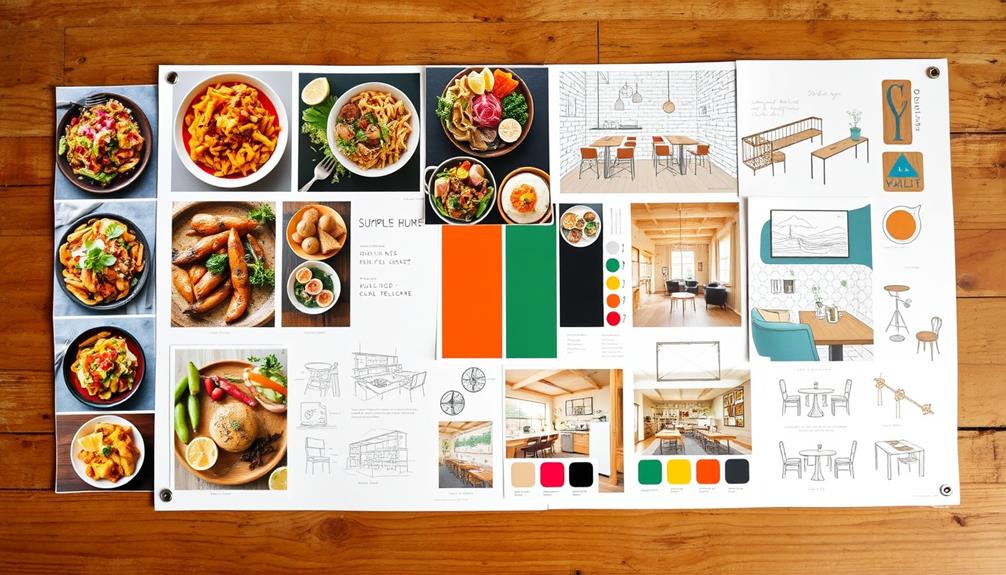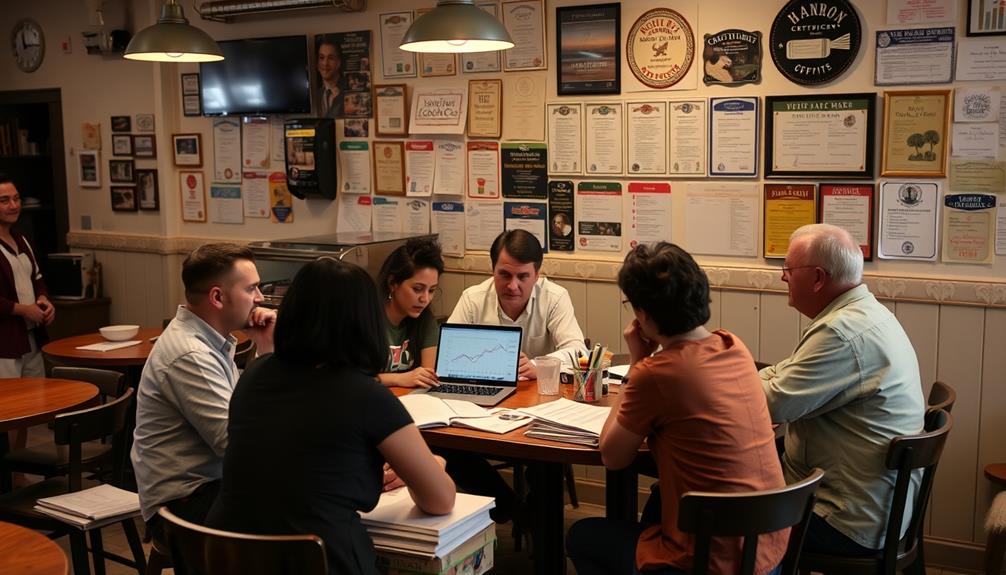To open a restaurant, you need to clearly define your concept and conduct thorough market research. A solid business plan follows, outlining finances and a unique menu. You'll need to secure funding, whether through savings, loans, or crowdfunding, along with the necessary licenses like a business and food service license. Choosing the right location is vital, so evaluate foot traffic and local competition. Don't forget about layout design and efficient kitchen operations. Finally, focus on hiring and training staff to create a great experience. If you keep going, you'll uncover more essential steps to bring your restaurant vision to life. Additionally, navigating the complex web of restaurant licensing requirements is crucial. Each city and state has its own regulations for health and safety, alcohol sales, and zoning. It’s important to research and comply with all necessary permits and inspections to ensure your restaurant operates legally. This includes obtaining a liquor license if you plan to serve alcohol, as well as adhering to food handling and sanitation guidelines to maintain a clean and safe establishment. Understanding and meeting these requirements will help your restaurant establish a solid foundation for success.
Key Takeaways
- Define a unique restaurant concept that resonates with your target demographic and stands out from competitors.
- Develop a comprehensive business plan detailing market analysis, financial projections, and menu concepts.
- Secure necessary funding through personal savings, loans, or crowdfunding, and obtain essential licenses for operation.
- Choose a strategic location with high foot traffic and favorable demographics while reviewing lease terms and zoning regulations.
- Hire and train staff effectively, focusing on key positions and implementing retention strategies to foster a positive work environment.
Define Your Restaurant Concept

When it comes to opening a restaurant, defining your concept is essential for setting the stage for your success. You need to identify a unique theme or cuisine that resonates with your target demographic. This foundation will shape your restaurant's identity and inform your marketing strategies. Conducting thorough market research helps you analyze customer preferences and existing competition in your area.
Additionally, focusing on high-quality content can enhance your restaurant's visibility and appeal to potential customers.
Your concept should differentiate your restaurant from others by offering a unique selling proposition—whether it's a signature dish, distinctive decor, or a specialized service format. This differentiation not only influences your menu offerings but also ties into your overall brand image.
When you clearly define your restaurant concept, you'll guide operational decisions, including staffing needs and training requirements. It's a roadmap that guarantees every aspect of your business aligns with your vision.
The name, logo, and interior design all contribute to a cohesive restaurant identity that attracts your target market. Remember, a strong concept isn't just a gimmick; it's crucial for building loyalty and long-term success. Define your restaurant concept, and you'll set yourself up for a thriving venture.
Develop a Business Plan

Having defined your restaurant concept, the next step is to develop a thorough business plan. This document should start with an executive summary and a company overview, laying the foundation for your vision.
Conduct a detailed market analysis to understand your target market and competitive landscape. Identify customer preferences and potential locations, which will help establish your unique selling proposition. Additionally, consider incorporating a budget plan to manage your initial costs effectively.
Your financial projections are essential, covering initial startup costs, ongoing operational expenses, and anticipated sales for the first few years. These figures can range from $95,000 to over $2 million, depending on your restaurant concept.
Incorporate a clear menu concept that aligns with your overall theme and caters to your target market. This will guide your culinary direction and pricing strategy.
Additionally, include a timeline of key milestones in your business plan, outlining critical steps from concept development to your grand opening. This will help keep your project on track and guarantee you're prepared for each phase of the journey.
Secure Funding and Licenses

To get your restaurant off the ground, you'll need to explore various funding options, like personal savings or loans.
Consider the potential for diversification of retirement portfolio if you're thinking about using retirement funds for your investment.
Additionally, securing essential licenses is vital for compliance and operation.
Knowing what you need will save you time and hassle down the road.
Funding Options Available
Securing funding for your restaurant is a critical step that can set the foundation for your success. You have several funding options to evaluate.
Commercial loans are a popular choice, typically offering lower interest rates, but they often require collateral. If your credit score is borderline, SBA loans may be the ideal route, as they cater specifically to entrepreneurs in your situation.
Additionally, you may explore innovative funding methods through top platforms for earning, such as freelance work or crowdfunding, to supplement your initial capital.
Crowdfunding platforms like Kickstarter and GoFundMe can also help you raise initial capital through community support and pre-sales of products. This approach not only provides funds but builds a loyal customer base before you even open your doors.
Startup costs for a restaurant can vary greatly, ranging from $95,000 to over $2 million, depending on your concept and location.
To attract investors and lenders, you'll need a detailed business plan that outlines your financial projections and clearly states your funding sources. This plan is essential for demonstrating your vision and the potential profitability of your restaurant.
Essential Licenses Required
Once you've sorted out your funding, the next step involves guiding you through the necessary licenses required to legally operate your restaurant.
These licenses and permits guarantee you comply with local and state regulations to keep your business running smoothly. Understanding the importance of proper documentation can enhance your confidence, similar to how astrology influences self-image.
Here are three essential licenses you'll need:
- Business License: This is vital for tax compliance and varies by county. Make sure to renew it periodically.
- Food Service License: You'll need this to pass a health inspection, guaranteeing your restaurant meets health standards. It can cost hundreds to over $1,000.
- Employer Identification Number (EIN): Obtained from the IRS, this number is necessary for hiring employees and managing tax obligations.
If you plan to serve alcohol, a liquor license from the Texas Alcoholic Beverage Commission (TABC) is mandatory, costing between $500 and $2,000, with a processing time of 30 to 90 days.
Additionally, a food handlers license is required for all employees handling food, guaranteeing food safety training, and might cost up to $15 per employee with periodic renewals.
Make sure to gather all these essential licenses for a successful restaurant launch!
Choose a Location

Choosing the right location for your restaurant is essential to its success. Start by conducting a thorough location analysis to evaluate foot traffic and visibility. High visibility can greatly boost customer visits and sales potential.
| Factor | Importance | Action Required |
|---|---|---|
| Foot Traffic | High | Analyze pedestrian patterns |
| Local Competition | Medium | Identify market gaps |
| Zoning Regulations | Critical | Confirm compliance |
Next, consider the demographics of the area to guarantee they align with your target market. This alignment influences your menu items and marketing strategies. Research local competition to find gaps in offerings, helping you position your restaurant uniquely.
Don't forget to review lease terms carefully. Understand rental rates, the length of the lease, and any hidden fees that could impact your financial viability. Finally, make certain that the zoning regulations permit restaurant operations to avoid legal complications that could delay your opening.
Design Your Layout

After selecting the perfect location for your restaurant, it's time to focus on designing your layout. A well-planned restaurant layout is essential for enhancing both traffic flow and the overall customer experience.
Reflect on how various elements, such as your choice of furniture and decor, can evoke a unique atmosphere that resonates with your target audience, similar to how different brewing methods can create unique coffee experiences.
Here are three key elements to take into account:
- Front-of-House Design: Your layout should create a welcoming atmosphere while balancing seating capacity with comfort. Use durable furniture that aligns with your overall restaurant concept to guarantee diners feel at ease.
- Kitchen Layout: Design your kitchen with efficiency in mind. Allocate specific zones for food preparation, cooking, and washing, adhering to safety standards. This organization promotes smooth operations and safe food handling.
- Flexible Seating Arrangements: Incorporate various seating styles to accommodate different group sizes and dining preferences. This flexibility not only maximizes occupancy but also enhances customer satisfaction.
Hire and Train Staff

Hiring and training staff is essential for the success of your restaurant, as the right team can elevate the dining experience and drive repeat business. To hire employees effectively, utilize diverse recruitment channels like industry job boards, culinary schools, and social media. Focus on filling key positions such as head chef, kitchen staff, and front-of-house personnel while complying with federal and Texas labor laws.
Additionally, consider implementing strategies for protecting seniors from financial scams, as training employees to recognize signs of potential fraud can create a safer environment for all patrons.
Implement thorough training programs that cover onboarding, food safety protocols, and customer service skills. These training programs guarantee consistency and high service quality from the start.
Providing competitive compensation packages, including health insurance and paid time off, enhances employee retention and job satisfaction in this high-turnover industry.
Regularly assess staff performance to identify areas for improvement and recognize achievements. Foster professional development opportunities, such as workshops or ongoing training, to keep your team motivated and skilled.
Prioritizing workplace safety and proper food handling training helps protect both your employees and customers. By focusing on these aspects, you'll create a motivated workforce that contributes positively to your restaurant's success.
Frequently Asked Questions
What Permits Do I Need to Open a Restaurant in California?
To open a restaurant in California, you'll need a business license, health permit, Alcoholic Beverage Control license if serving alcohol, a seller's permit for tax collection, and a Certificate of Occupancy for zoning compliance.
How Much Money Should You Have to Open a Small Restaurant?
You should plan for startup costs between $95,000 and $2 million, factoring in equipment, inventory, and permits. It's wise to have 3 to 6 months' operating expenses saved for a smoother launch.
What Type of Certificate Is Required to Run a Restaurant?
To run a restaurant, you absolutely need a Certificate of Occupancy! It's the golden ticket that proves your place meets all zoning and safety standards. Without it, you can't even think about opening your doors!
How Much Does It Cost to Start a Restaurant in Texas?
Starting a restaurant in Texas typically costs between $95,000 and over $2 million, depending on factors like size, concept, and location. You'll need to budget for equipment, renovations, licenses, and initial inventory.
Conclusion
Opening a restaurant is like crafting a recipe; each ingredient plays a crucial role in your success. As you define your concept, secure funding, and choose the right location, remember that every detail matters. With passion and dedication, you can turn your vision into a thriving reality. So roll up your sleeves, embrace the challenges, and watch as your dream unfolds, one delicious dish at a time. You've got this!









